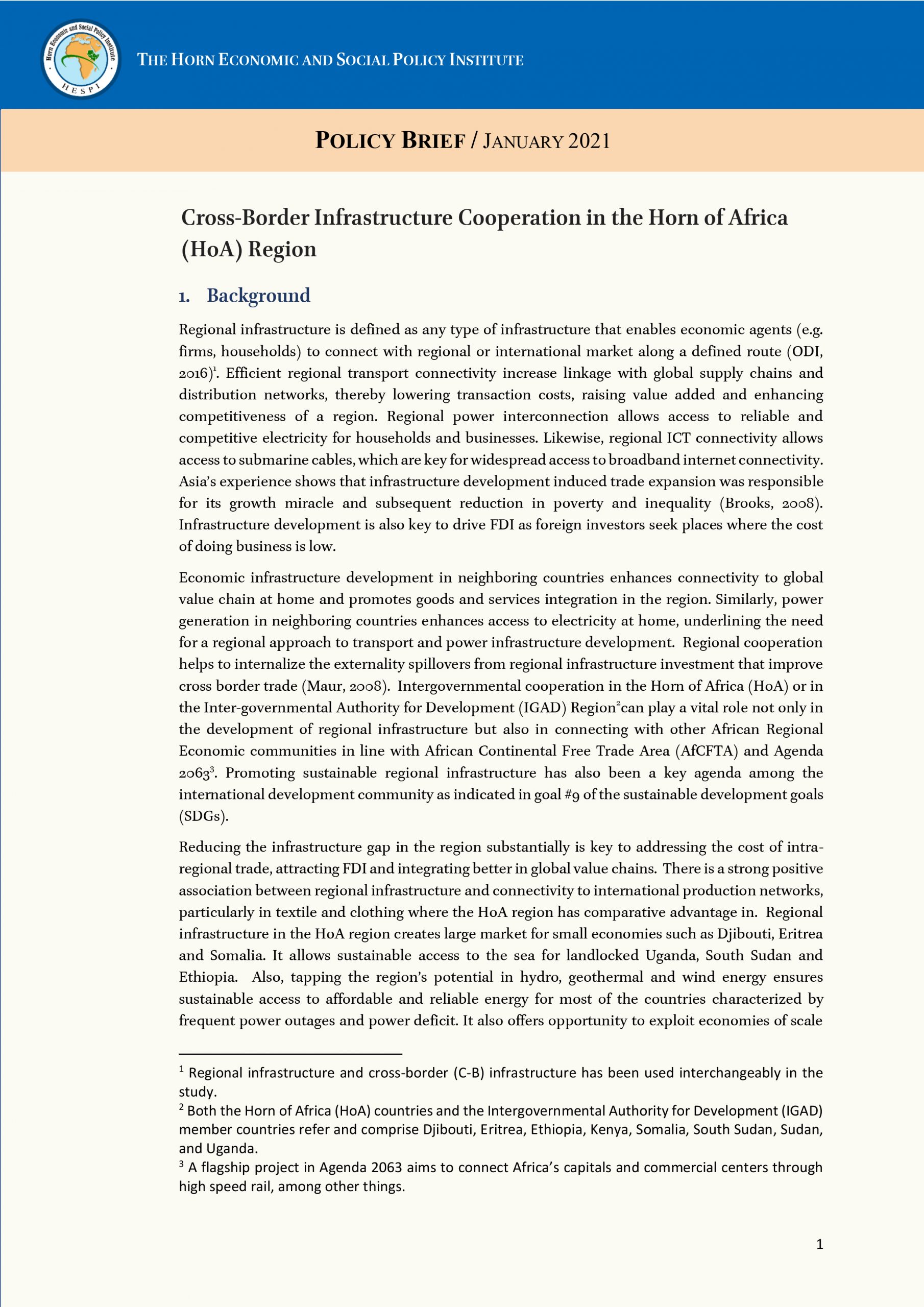Cross-Border Infrastructure Cooperation in the Horn of Africa (HoA) Region
--------------------------------------------------------------------
 Regional infrastructure is defined as any type of infrastructure that enables economic agents (e.g. firms, households) to connect with regional or international market along a defined route (ODI, 2016). Efficient regional transport connectivity increase linkage with global supply chains and distribution networks, thereby lowering transaction costs, raising value added and enhancing competitiveness of a region. Regional power interconnection allows access to reliable and competitive electricity for households and businesses. Likewise, regional ICT connectivity allows access to submarine cables, which are key for widespread access to broadband internet connectivity. Asia’s experience shows that infrastructure development induced trade expansion was responsible for its growth miracle and subsequent reduction in poverty and inequality (Brooks, 2008). Infrastructure development is also key to drive FDI as foreign investors seek places where the cost of doing business is low.
Regional infrastructure is defined as any type of infrastructure that enables economic agents (e.g. firms, households) to connect with regional or international market along a defined route (ODI, 2016). Efficient regional transport connectivity increase linkage with global supply chains and distribution networks, thereby lowering transaction costs, raising value added and enhancing competitiveness of a region. Regional power interconnection allows access to reliable and competitive electricity for households and businesses. Likewise, regional ICT connectivity allows access to submarine cables, which are key for widespread access to broadband internet connectivity. Asia’s experience shows that infrastructure development induced trade expansion was responsible for its growth miracle and subsequent reduction in poverty and inequality (Brooks, 2008). Infrastructure development is also key to drive FDI as foreign investors seek places where the cost of doing business is low.
Economic infrastructure development in neighboring countries enhances connectivity to global value chain at home and promotes goods and services integration in the region. Similarly, power generation in neighboring countries enhances access to electricity at home, underlining the need for a regional approach to transport and power infrastructure development. Regional cooperation helps to internalize the externality spillovers from regional infrastructure investment that improve cross border trade (Maur, 2008). Intergovernmental cooperation in the Horn of Africa (HoA) or in the Inter-governmental Authority for Development (IGAD) Region can play a vital role not only in the development of regional infrastructure but also in connecting with other African Regional Economic communities in line with African Continental Free Trade Area (AfCFTA) and Agenda 2063. Promoting sustainable regional infrastructure has also been a key agenda among the international development community as indicated in goal #9 of the sustainable development goals (SDGs).
Reducing the infrastructure gap in the region substantially is key to addressing the cost of intra- regional trade, attracting FDI and integrating better in global value chains. There is a strong positive association between regional infrastructure and connectivity to international production networks, particularly in textile and clothing where the HoA region has comparative advantage in. Regional infrastructure in the HoA region creates large market for small economies such as Djibouti, Eritrea and Somalia. It allows sustainable access to the sea for landlocked Uganda, South Sudan and Ethiopia. Also, tapping the region’s potential in hydro, geothermal and wind energy ensures sustainable access to affordable and reliable energy for most of the countries characterized by frequent power outages and power deficit. It also offers opportunity to exploit economies of scale through joint investment in large scale power projects. Upgrading the regions ICT network adds another dimension to the connectivity with global markets. These enhancements facilitate structural transformation of the economies, ensures sustainable growth and job creation.
However, Inception of regional infrastructure and its sustainable use by regional actors depends on how well the parties have negotiated on the design, level of investment, financing modalities to recover maintenance costs, and appropriation of the benefits. It also depends on the regional institutions and regulatory procedures governing its operation.
Although there have been considerable progress in recent years, the HoA countries have one of the lowest economic infrastructure, in particular regional transport, power infrastructure and information and communication technology (ICT) Connectivity. Accordingly, the region is characterized by low intra-regional trade, high cost of trade logistics, and low ICT connectivity, low proportion of the population with access to electricity and high average electricity tariff despite the region’s high potential in renewable energy sources.
